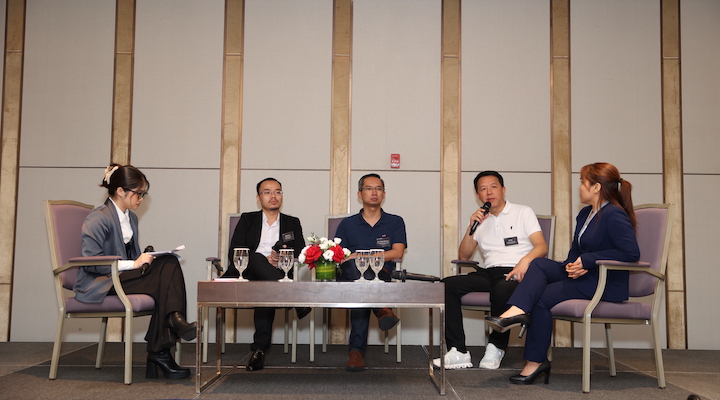Vietnam, one of Asia’s hottest manufacturing hubs, is not immune to the global economic downturn – particularly in its garment export sector.
Like most other industries enduring challenging global economic conditions, the sector is facing significant pressure as retail brands slash orders owing to lower consumer demand, especially in the US and Europe.
Centric Software partnered with CSP (the representative of Optitex in Vietnam) to convene a seminar in Hanoi on October 19. Themed ‘Adapting to Shifting Demands with Tech-driven Solutions for the Garment Industry’, the event featured industry experts who discussed the challenges of Vietnam’s garment export industry and provided insights to help apparel brands and manufacturers thrive in the current volatile market.
Guest speakers were Tran Ngoc Minh Tri, SEA operational excellence manager at Decathlon Vietnam; Alex Luu, commercial director of Centric Software; Ji Fei, vice GM of Xinlin Group; and Nguyen Thi Minh Tho, sales director of CSP and representative of Optitex in Vietnam. While this feature explores the challenges and solutions for manufacturers and retailers to cope with market change, the next article will feature insights from experts on the importance of digitalisation in the garment industry.
The country’s textile and garment exports last year reached US$37.6 billion, increasing 14.7 per cent year on year according to data from the customs IT and statistics department, General Department of Customs, and Vietnam’s Ministry of Finance. However, in the first eight months of this year, textile and garment export sales fell 16 per cent year on year to US$26.1 billion.
“The market remains uncertain, especially now we have the Israel-Hamas war. For now, we hope the most difficult period is over,” said Tran Ngoc Minh Tri.
According to Ji Fei, the country’s garment export slump is much worse.
“Some factories’ sales were down 50 per cent or more, some were down from 20 to 30 per cent,” Fei said. “Vietnam’s market has experienced a decline for the first time in around 20 to 30 years. No one had experienced it previously due to the country’s [strong] GDP and all sectors have been expanding rapidly over the previous 10 years. The Global Financial Crisis, and inflation this time around, persisted longer than previous declines.”
“What we learned from the Covid-19 pandemic is that the US will be the quickest and most impacted market, followed by Europe and Asia. Now, that the confidence in the ratio and customers in the US have started to increase, we do hope the end of this year or the middle of next year will see normalcy return.
Fei recommended apparel manufacturers look to expand into new business models or fields to adapt to the uncertain demand and Tri advised companies to preserve cash flow and pay careful attention to stock levels.
“We need to take care of efficiency. We take this opportunity to train the workers and introduce new skills to enhance competency,” Tri added.
Despite having advantages over China, Fei said the challenges the country faces include a lack of highly skilled labour and the rising cost of living. According to a report by McKinsey, while Vietnam’s labour productivity has gradually improved over recent years, it remains behind some Asian peers. As of 2021, Vietnam ranks 136th out of 185 countries in labour productivity.
Meanwhile, Tri advised manufacturers to also expand their market, even if they already have customers in the US and Europe. As a business leader with extensive experience in sourcing products, he said brands are now looking more for autonomous and innovative suppliers to increase their competency.
Struggling to secure more orders from clients as competition with other traditional sourcing markets like Bangladesh and India intensifies, manufacturers in Vietnam are being forced to seek innovative solutions in order to adapt to the changing market conditions and increase their competitiveness – including the adoption of digital solutions – to stay ahead.
“Having worked in the sector for many years, I believe that if you want to differentiate yourself from other manufacturers, be closer to buyers, or adjust to the market as quickly as possible, digital solutions are essential, said Tho.
Alex Luu of Centric Software touched on the need for tech-driven solutions to help streamline operations and increase efficiency.
“Before the Covid-19 pandemic, some forward-thinking factories already invested in Centric Software. We learned that the more you engage, the more you make customers depend on you,” Luu said.
“When Covid happened, most of the industries went down. However, for Centric, we reported about 50 per cent growth annually due to the boom of digital transformation, which was happening before Covid, but many companies had not noticed.”
According to Luu, manufacturers are well-versed in business models, including own design manufacturing (ODM) and original equipment manufacturers (OEM). When the models were implemented, though, many manufacturers found it challenging to communicate with customers.
Centric Software pioneered the concept of Product Lifecycle Management (PLM) software for retailers, brands and manufacturers in the consumer goods industry to optimise product development processes by connecting all activities and product data in a centralised platform. It helps manufacturers better oversee the complex processes involved in designing and delivering products, increase speed to market, optimise cost and boost innovation. Leading manufacturers including Scavi, Biti’s, Nhabe Garment, Busana Apparel Group, VT Garment, and MAS Holdings use Centric Software. Click here to learn more about their best practices.






